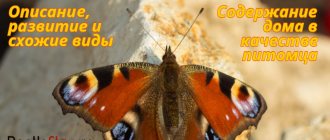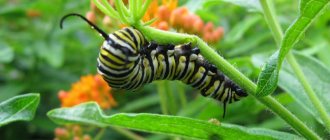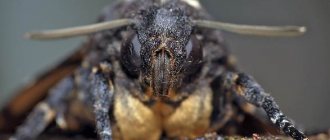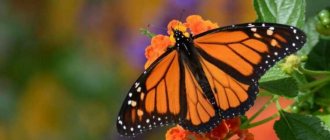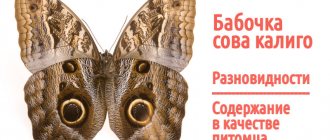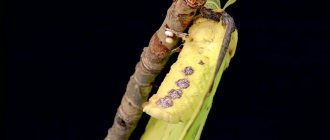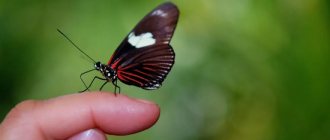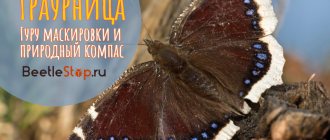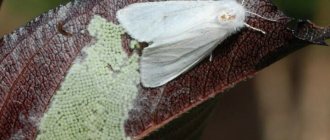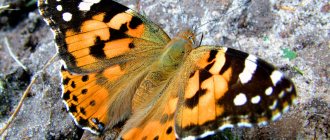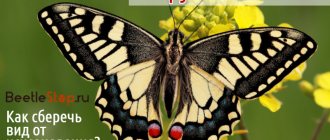The principle of suspended animation of lepidoptera
Many species of butterflies spend the winter in the egg stage. The crimson silkworm waits in the form of a caterpillar for the warm season, but this is rather an exception to the rule. Most Lepidoptera hibernate while in the pupal stage. Many of them are so hardy that they can spend the entire winter on a tree branch or other open area, without fear of frost and piercing wind.
Almost all caterpillars have a bright appearance, since in this way they demonstrate to enemies that they are inedible, while others camouflage themselves in the green part of plants. The duration of the life cycle directly depends on climatic conditions. In northern latitudes, caterpillars may go into diapause (fall asleep) until spring. In such a situation, development can take from 4 to 10 years. It is quite difficult to reproduce the full life cycle of these insects at home.
Some caterpillars prefer to choose secluded places in the bark of old trees, where they turn into pupae and wait for the onset of spring. In the adult stage, the following butterflies hibernate:
- Hives.
- Lemongrass.
- Painted lady.
Mourning butterflies are helped to avoid freezing by a special liquid that they independently produce. It contains various cryoprotectors that provide excellent protection against frost. The behavior of butterflies largely depends on the species and climatic conditions.
Even in closely related species of the same genus that live in different regions of the country, diapause occurs at different phases of development. For example, the first generation of burdock butterflies goes south in the fall, and the second generation returns back in the spring. Thanks to this, these lepidopterans disappear from view only during cold weather, and with the arrival of warmth they can again be observed in different regions of Russia.
Lifestyle
The main method of movement of butterflies is flight. It can be active with flapping wings or passive - gliding. Sometimes insects make long flights in search of food. What does the peacock butterfly eat? Like most lepidopterans, it sucks nectar from flowers. Among the insect's taste preferences:
- dandelions;
- marigold;
- elder;
- clover;
- marjoram;
- buddleya.
In addition to nectar, they consume the sweet juice of slightly rotten fruits and drink secretions on tree bark.
Peacock's eye is a diurnal butterfly that is active during daylight hours. In mid-latitudes, one generation is replaced per year; in the south, two generations manage to develop. The first generation of adults appears in June-July, the second in August-September. How long does a peacock butterfly live? Among insects, she is a long-liver - her life span is almost a year. The butterfly spends a significant part of the cycle in a state of suspended animation or hibernation.
Butterfly wintering
One of the notable features of the butterfly is its wintering in the adult state. With the onset of cold weather, representatives of the second generation look for reliable shelters for the cold season. They hide in the forest floor, under the bark of trees, in the cracks of outbuildings, and in attics. By folding their wings, insects fall into suspended animation, their life processes slow down. In winter, butterflies find themselves defenseless against attacks from predators; if there is insufficient accumulation of nutrients, they can die of starvation. Premature rise in temperature is dangerous. During the thaw, the peacock's eye wakes up and leaves its shelter. The second time it is more difficult for the insect to settle down for the winter.
Defense mechanism
Butterflies have many natural enemies, these include birds, rodents, reptiles, and large insects. To frighten the enemy, the peacock's eye has an unusual coloring. When attacked by birds, the butterfly suddenly opens its wings. The appearance of widely spaced eyes disorients the predator, and in some cases forces it to retreat. Even a short delay is enough for an insect to escape from the enemy.
Popular message topics
- Living cells We are all living beings, be it a person, an insect, a plant, and all of us, consisting of numerous “bricks” called a cell. Our body consists of billions of small particles, where each cell is a small, actively functioning living thing.
- Cherry fruits Cherry is a common fruit crop, which is a large shrub. Belongs to the Rosaceae family, the Plum genus, and the Cherry subgenus.
- Schubert Franz Schubert is a composer who was a representative of such a movement as romanticism in music. This style differed from the strict, calm classics with an explosion of emotions and feelings. The music excited me and made me empathize.
Reproduction
Butterflies exhibit complex forms of courtship in the form of flights and mating dances. Males divide the territory into separate areas, where they wait for incoming females. After wintering, butterflies appear in early spring, and they are the ones who produce the first generation. The search for partners is facilitated by the distribution of pheromones. After fertilization, the female lays 100 to 300 eggs on the underside of the leaves of food plants. Most often it is nettle. Laying begins in early May. The embryo matures for one to two weeks, then the caterpillar appears.
Caterpillars are equipped with gnawing type mouthparts; they feed day and night with short rest breaks. At the first instar, the length of the larvae is about 2 mm, in the second it is already 8 mm. They grow quickly, eating all the leaves on the plant. In addition to nettles, insects settle on raspberries, hops, willow or birch leaves. The number of days between molts varies; in total, caterpillars go through five instars. The larval stage takes about a month. Before pupation, the caterpillars crawl in different directions.
The larvae have their own defense mechanisms. When attacked by predators, they take a threatening pose and begin to simultaneously move in different directions. This scares off the attacker. In addition, the caterpillars secrete an unpleasant green liquid and can curl up into a ball and fall to the ground. The angular, grey-green or brownish-gold colored pupa can be seen on walls, branches or stems. The color depends on the location chosen for pupation. This stage, depending on the ambient temperature, lasts 2-3 weeks.
The length of the pupa is 25-28 mm, it is formed upside down. The rudiments of wings, proboscis, and abdomen are visible. The first generation of butterflies appears at the end of June. The cocoon ruptures along the head and the leading edge of the wings.
Features of biology
Aberration semi-ocellata
Develops in one generation in the steppe and forest-steppe zones;
in Crimea and Ciscaucasia - two. Butterflies emerge from their pupae in early June. Adults are often found on flowers of greenweed, thyme, Scabiosa ochroleuca
(genus Scabiosa), Cirsium hetcrophyllum
(genus Bodyak), felt burdock and various garden plants. Sometimes they are found on leaking tree sap or fermented fruit.
The first generation flies from late June to mid-July. The second generation flies from August to September, wintering in protected places. Females of the second generation are found until the end of October, overwinter and are found again in early spring until early June. Overwintering individuals can be found in winter during thaws. In the southern regions it can produce three generations.
Features and habitat of the peacock butterfly
Representatives of this family are characterized by medium size and a small wingspan: from 25 to 180 mm. The presented size is the average for the entire species, but it is different for each sex of butterflies:
- the wingspan of males is from 45 to 55 mm; -the wingspan of females is from 50 to 62.
However, there is a large peacock butterfly, the wingspan of which reaches 15 cm. In addition to its small size, the butterfly has other differences among representatives of its species. One of these differences is the uneven edge of the wings: they generally have an angular shape and ragged edges.
In the photo there is a large peacock eye butterfly
The color scheme also makes it stand out from the rest. The colors presented on the wings are vibrant and create a pattern identical to that on the peacock's tail. The general color of the butterfly includes the following shades:
-black – this is how the insect’s body and pattern on the wings are colored; - red – the color of the fluff on the body; -red – the color of the wings; -gray-pockmarked – the color of the pattern on the wings; -gray – the color of the pattern on the wings; - blue-blue - the color of the pattern on the wings.
It is because of the listed color of the wings that the butterfly got its name. For a more visual examination, we offer you a photo of a peacock butterfly, where our insect is presented from a better angle.
In addition to the color of the peacock butterfly and its size, the insect is distinguished by its activity time. Based on the name of the daytime peacock eye, we can safely say that it is awake during the daytime, unlike its relatives. We also note that this name distinguishes the butterfly from other peacock eyes and from the night peacock butterfly, with which it is often confused.
Butterfly peacock eye red
Based on the information above, it turns out that there are about 5 differences that will help any lepidopterist to recognize this particular species and admire it.
Also, this description of the peacock eye butterfly helps a person recognize it from thousands of other lepidopteran species. So, we have examined the features of the peacock eye butterfly, then we will indicate its habitat.
Europe is considered the classic place of life for the peacock butterfly insect; it is especially often noticed in Germany. But the activity of this species was noticed in places such as the subtropics of Eurasia and the Japanese islands.
Its main habitat:
-meadow; -wasteland; -steppe; - forest edge; -garden; -a park; -ravine; -mountains.
In addition to the listed places, we note that this species of lepidoptera lives on nettles. In the listed places, the peacock butterfly can be seen from spring to mid-autumn.
In addition to the warm time of day, this butterfly is active in the subtropical zone during the winter thaw. With the arrival of winter, the insect hides in cracks on the surface of tree bark and in leaves. Having found shelter, she plunges into the imago phase or sleep. This condition is typical for individuals who have reached adulthood.
Habitat
Daytime peacock eye is the name of a species that is part of the nymphalidae family. In Latin it is called Aglais io, and even earlier it sounded like Inachis io in honor of the characters of ancient Greek mythology - the river god Inach and his daughter Io.
The butterfly lives in extratropical Eurasia and throughout Eastern Europe, with the exception of the Far North and deserts. It can also be found in Japan. There are especially many representatives of the species in Germany. In particular, thanks to this fact, the peacock eye became the symbol of the year in Germany in 2009, although this action is usually carried out for rarer species.
However, there are also places where this species is never found. These include the Greek island of Crete and North Africa.
Description of the species
The beauty of butterflies invariably attracts the admiring glances of fauna lovers. The photo shows one of the amazing creations of nature, the peacock butterfly. She is a typical inhabitant of garden plots and forest clearings. Prefers free, well-lit areas rich in flowering vegetation. In dense forests, she runs the risk of damaging her scaly wings on tree branches.
Insect taxonomy:
- family - Nymphalidae;
- genus – Aglais (urticaria);
- species – Inachisio Daytime peacock eye.
The family of nymphalids is characterized by variegated wing colors on the outside and protective colors on the inside. Many of its representatives tend to migrate in search of better food places. The genus of wrens is not numerous, it includes only 6-7 species, including the day peacock butterfly.
The peacock eye is not large in size, the length of its front wings is 30 mm, the span is 60-62 mm. The wings are wide, the outer edge with serrations and angular projections. Their main background is reddish-brown or red. A grayish-brown stripe runs along the edges. At the top of the front and rear pairs of wings there is a characteristic pattern in the form of an eye with a blue center. It is surrounded by yellowish, white and black rings. In the description of the peacock butterfly, one should note the protective coloring on the underside of the wings. On a dark background, light brown sinuous lines create an imitation of a dry leaf.
The head is round, the mouthparts are of the sucking type, with a proboscis. The antennae are club-shaped. The eyes are complex, faceted, and shaped like hemispheres. The chest consists of three segments. The front legs are reduced. They are not used when walking; insects move on their middle and hind legs. In the middle of the front shin there is a spur for cleaning the antennae. Sexual dimorphism is manifested in the structure of the antennae and size - females are slightly larger than males.
Peacock-eye Atlas
It is worth noting that female Atlas Peacock-eyes are much larger than males. Individuals feed on leaves of bushes and trees. And like previous record holders, they lead a nocturnal lifestyle. They are especially active during twilight, early morning and late evening, which is why they received the nickname “Prince of Darkness.” And the best way to observe the largest butterflies in the world is not in person, but in photographs. However, residents of Russia can see the beauty without leaving the country - Atlas Peacock-Eyed is bred in the Moscow Zoo.
By the way, the Atlas Peacock-eye species itself is quite interesting. During mating periods, a male can detect a female at a distance of up to several kilometers. And the mating itself lasts several hours without interruption. Immediately after emerging from the pupa, both the male and female are ready to reproduce. Peacock-eyes are unusually patient; females can wait for their male for several hours, while sitting motionless in one place, while the male will look for her at this time. And it is precisely this process, that is, reproduction, that is the meaning of life for the largest butterfly in the world. By the way, the life of a female is quite short. She dies immediately after laying offspring.
By the way, in Taiwan, Peacock Eyes without knowing it benefit people. People use caterpillar cocoons as wallets.
The largest butterfly in the world amazes with its beauty. The winged individual can be colored in bright red, yellow, pink and brown shades. And on each wing of the butterfly there are large triangular transparent “windows”. The front wings have a rather bizarre curved edge, which in shape and color resembles a snake's head. This is what the Peacock Eye scares away insectivorous animals. By the way, in Hong Kong, for this unusual feature, Atlas was nicknamed “The Moth - the head of a snake.”
In addition to its size, Peacock-Eyes has one more feature - its mouth is completely atrophied. Throughout its short life (only 1-2 weeks), the butterfly does not feed on anything, but processes all the fat reserves that it accumulated as a caterpillar.
By the way, the caterpillars of the giant butterfly are also huge - they grow up to 10 centimeters in length. And their appearance is original - they are light green in color with large blue processes throughout the body, which are covered with a waxy white coating (similar to powder).
Peacock-eye Atlas is not only a beautiful, but also a useful butterfly. In India, it is bred on special farms where fagar silk is obtained. It differs from the silkworm product in its wooliness, strength and durability.
The structure and lifestyle of butterflies
Among invertebrates, butterflies are distinguished by their complex body structure and attractive appearance. The body of Lepidoptera consists of a head, abdomen, proboscis, chest, antennae, two pairs of wings and three pairs of legs. Butterflies are distinguished by their natural beauty. The wings of these insects have different colors and patterns. The coloration of Lepidoptera can be of two types: optical (depending on the refraction of light) and pigmentary.
During their life, these insects go through several transformations. The diet of Lepidoptera includes only liquid food, which they can consume thanks to their proboscis. Most often it is pollen, flower nectar, and tree sap. They can also take nutrient liquid from puddles and plant leaves.
Some Nymphalidae insects need additional moisture and various microelements. For this reason, they can use the excrement and urine of large animals, wet clay, and human sweat. Science knows for certain that butterflies from the Amazon rainforest drink the tears of turtles and crocodiles. But the males of some species of cutworms use animal blood to maintain vital energy.
The wings of lepidoptera consist of two pairs, which have a membranous structure and are penetrated by longitudinal and transverse veins
The color can be very different, which is very important for protecting insects. Multi-colored wings allow you to easily blend into your surroundings to hide from predators
Life expectancy depends on the habitat, type and size of lepidoptera. The smallest butterflies can enjoy the beauty of this planet for just a few days. Tropical forests are home to some of the largest species of Lepidoptera, with a lifespan of 2-6 months. Representatives of middle latitudes can live for 1 month, and representatives of northern latitudes - up to 2 years.
Lepidoptera can be found on almost all continents of the planet, but with the exception of Antarctica. Most butterflies live on the islands of the Pacific Ocean, in Greenland, as well as in the highlands of the Himalayas. Lepidoptera belong to the category of cold-blooded insects. They are able to regulate their own body temperature, taking heat from the outside or gradually releasing it to the environment. Zoologists have characterized butterflies as insects with a full cycle of transformation, since their development goes through all stages: egg → caterpillar → pupa → adult.
Conditions of detention
From an aesthetic point of view, it is more interesting to keep daytime butterflies, but it is worth considering that these insects are also attracted to light. During the day, the pet will tend to the window or sit on the curtains, and with the onset of darkness it will be drawn to all the lamps that are on.
Of course, the butterfly needs to be released to fly around the apartment, but it must have its own home. For this you can use:
- Plastic container;
- large glass jar;
- insectarium.
An insectarium equipped with special equipment or at least a large plastic container will be required when breeding butterflies
And with normal maintenance, this is important if other animals live in the house, especially cats. Otherwise, with a butterfly flying freely around the apartment, there will at least be no curtains on the windows
And during the hunt, both pets can suffer.
At temperatures from +22 °C and humidity within 60-80%, butterflies are active throughout the day. If the air in the apartment is excessively dry, the insect is sprayed with a spray bottle 1-2 times a day from a distance of about 30 cm from the wings.
The more time the pet spends in free space, the better. Some owners only place the insect at night in an ordinary box, where they put a sponge moistened with water, and during the day they let it fly around the apartment.
And now the main question that worries potential owners of winged beauties: what to feed a butterfly at home?
Related species of butterflies
Butterflies of the peacock-eye family have similar wing colors and eye patterns. These are large insects with a wingspan of 12-15 cm. They are active in the dark. A distinctive feature of the family is its reduced oral apparatus. Insects do not feed at the adult stage. They live off the nutrients accumulated by the caterpillar.
Great night peacock eye
The pear peacock eye or saturnia is a butterfly common in Southern and Central Europe, the Caucasus and Asia Minor. The wingspan is up to 155-160 mm, one wing is 55-70 mm. This is the largest nocturnal butterfly in Russia and Europe. At dusk or mistaken for bats. Females are larger than males, they have short comb-like antennae, and the proboscis is underdeveloped. The main color of the wings is grayish-brown. There is a black stripe at the base, the edges of the front and rear pairs have a light border. Almost in the middle of each wing there is a visible ocellus with a dark center and a light ring.
The summer time of the night peacock butterfly is May-June. This is a heat-loving species that does not tolerate frost. They can be found in North Africa, Turkey, the Mediterranean, southern Europe, the Caucasus, Iran, Syria. Their habitats are forests and parks with a lot of bushes. Females are sedentary, males are much more active, flying even during the day. But females live almost 3 times longer - 20 days versus 8. The favorite food tree of Saturnia caterpillars is pear. But they happily feed on cherries, apples, plums, quinces, almonds, and maples. The caterpillar grows up to 10 cm and changes color several times during its life. The large peacock eye produces one generation per year; the pupa goes to winter.
Lesser night peacock
The small peacock eye also belongs to the genus Saturnia. Unlike the great peacock's eye, it is found throughout the Palearctic. Wingspan up to 60 mm. The male has reddish-gray forewings and orange hindwings. Females have a more modest coloration of light gray. The pattern is represented by wavy lines and bands of dark brown and yellowish color. Each wing has an ocellus - the middle is dark, the border is black and light.
Adults do not feed and live 3-4 weeks. Caterpillars live on thorns, raspberries, blackberries, willows, birches, and heather. The larvae have to stock up on food for the pupa and butterfly. The insect overwinters at the pupal stage, and begins to fly in April-May.
Creating favorable conditions for the existence of butterflies
Where humans have not yet had time to interfere with the usual life of the biosystem, the peacock butterfly most often lives.
The main reason explaining this fact is the destruction by people of low-value plants - the usual food products of butterflies. Although they are provided with preserves untouched by civilization for living, nevertheless, concern for their safety will not seem superfluous. It consists in not endangering the caterpillars, and also in the outskirts of fields and meadows to promote the free growth of nettles and burdocks. After all, these types of plants do not belong to harmful weeds. Now you know what a peacock eye looks like, what it eats and how long it lives.
The peacock eye is one of the brightest European butterflies, getting its name from the characteristic eye spots on its wings. This species belongs to the nymphalidae family and is related to the more modest checkerworts, pearlworts and wrens. This species is often called the day peacock's eye to distinguish it from several species of peacock butterflies, which are sometimes also called "peacock's eye". To avoid confusion, this article will specifically describe the daytime peacock eye, and the remaining species will be discussed in the article on peacock eyes.
Peacock's eye, or daytime peacock's eye (Inachis io).
The peacock eye is a medium-sized butterfly, with a wingspan of 45-55 mm for males and 50-62 mm for females. The body of the peacock eye is black, the upper side is covered with reddish fluff, and the antennae are club-shaped. The shape of the wings is quite simple, with shallow cutouts along the edges. The main color of the upper side of the wings is red; narrow gray-pockmarked stripes of black spots run along the anterior edge of the fore wings. The outer edge of both pairs of wings, as well as the posterior edge of the hind wings, have a gray edge; large blue-blue spots are present on all four wings.
The underside of the wings of the peacock's eye looks gloomy - it is black-brown with small gray ripples.
Although the peacock eye is considered a typical inhabitant of Europe, the range of this species is very wide. This butterfly is found throughout the temperate and partially subtropical zones of Eurasia and on the Japanese Islands. The peacock eye inhabits open biotopes - meadows, wastelands, steppes, forest edges, gardens, parks, ravines; in the mountains it is found at an altitude of up to 2500 meters. The peacock's eye is not found in dense forests and deserts; it is also absent in polar regions (tundra). These butterflies fly from early spring to October, and in warm subtropics they can be found even during winter thaws. In the northern regions, the peacock eye manages to produce one generation per summer, in the southern regions - two. These butterflies overwinter in the imago (adult) phase; in the fall, the butterflies hide in crevices in the bark, forest and steppe litter. The lifespan of each individual is several months.
Peacock's eye eggs on the underside of a leaf.
Peacock eye caterpillars feed on various plants, but especially love nettles, raspberries, hops, and are less common on willow and hemp. But adult butterflies most like to drink the nectar of thistle, burdock, scabiosa, thyme, they can visit various garden flowers, and often sit on damp soil, bark with flowing plant juice.
Peacock eye caterpillars.
The breeding season begins early; overwintered butterflies lay eggs in late April-May. The female lays small light green eggs on the underside of leaves in groups of 100-300 pieces. The caterpillars are black in color with thin projections; often caterpillars of the same brood stick together and fly around the stems with silky threads, creating a bag-like cocoon. Caterpillars of the spring generation are found in May-June, caterpillars of the summer generation - in late July-early August. The pupae are attached to plant stems with their heads down, depending on which stem the pupa is attached to (a green twig or a dry woody one), it can be greenish-gray or brown. The pupa looks spiny and develops in 1-2 weeks.
Peacock's eye on a sedum inflorescence.
The peacock eye is a fairly common butterfly in places where people do not interfere with natural biosystems. In cultivated landscapes, the peacock's eye is less common because its caterpillars feed on low-value plants, which people try to get rid of. Despite the fairly high number of this butterfly in protected and untouched places, it still needs protection. To increase the number of peacock eyes, it is enough to leave untouched thickets of burdock and nettle in meadows and fieldsides (especially since these plants do not infest crops), and not destroy its caterpillars (although they look unattractive). In this case, beautiful butterflies will often delight our eyes.
Choosing a place for wintering
Many butterflies lay eggs in the summer to produce a new generation and then die. But there are real long-livers. If you need to find out what winter butterflies live in Russia, then you should turn to trusted sources. Wikipedia states that lemongrass, urticaria and burdocks live on the territory of the Russian Federation, which simply sleep in winter. They climb into hollow trees, various crevices and wrap themselves in their wings. Many insects prefer to prepare thoroughly for wintering, which is why they try to find a reliable place closer to human habitation.
To understand where butterflies go in winter, you need to take into account that science knows the migration of lepidopterans, which, huddled in flocks of up to 1 million individuals, fly to warmer climes in the fall. But even numerous experiments by scientists could not explain how exactly these creatures find the right path. The thing is that they have a primitive nervous system, which is why they cannot navigate by the sun.
The caterpillars of some species of bluebirds prefer to live inside large anthills. Worker ants carry insects to their nest. In such conditions, the caterpillars live until they pupate and become an adult butterfly. All this time, the ants not only feed the caterpillar, but also try to do everything possible to protect it from various dangers. This happens for the reason that the insect makes the same sounds as the queen ant.
Diet
As for the nutrition of caterpillars, it should be noted that they are omnivorous, i.e. Any plant food is used. But still in first place are the following plants: nettle, hops and raspberries; on the second - willow and hemp. The favorite food of adult butterflies is nectar. They find it in thyme, burdock, thistle, scabiosis and flowers in the garden. In search of life-giving moisture, they sit on wet soil and feed on plant sap, which appears on the bark from time to time.
Rules for keeping at home
Butterflies prefer to spend the winter exclusively in a cool place. Otherwise, they may not survive until spring. This is due to the fact that during hibernation, lepidoptera's metabolism accelerates, which is why the aging process proceeds much faster. Peacock butterflies are common in Russia, preferring to overwinter in hollow trees, attics of houses, and also in basements. Lepidoptera begin to look for a suitable secluded place in the fall, when they sense the approaching cold weather.
If the butterfly is grown in an apartment, then it must be euthanized artificially. Such insects fall asleep at temperatures below 15 degrees
The butterfly should be carefully placed in a dry jar or box with small holes for oxygen access. But before that, the insect needs to be well fed.
The jar/box with the butterfly should be left until spring on a glazed balcony, where it is cool and dry.
Butterflies are increasingly grown at home, as they have an attractive appearance and are easy to care for. But in order for an exotic insect to live in an apartment or house for as long as possible, it is necessary to create favorable conditions for it, ensure proper feeding and a good wintering.
Features of biology
Aberration semi-ocellata
Develops in one generation in the steppe and forest-steppe zones; in Crimea and Ciscaucasia - two. Butterflies emerge from their pupae in early June. Adults are often found on flowers of greenweed, thyme, Scabiosa ochroleuca
(genus Scabiosa),
Cirsium hetcrophyllum
(genus Bodyak), felt burdock and various garden plants. Sometimes they are found on leaking tree sap or fermented fruit.
The first generation flies from late June to mid-July. The second generation flies from August to September, wintering in protected places. Females of the second generation are found until the end of October, overwinter and are found again in early spring until early June. Overwintering individuals can be found in winter during thaws. In the southern regions it can produce three generations.
How to care for a peacock butterfly
Some wildlife lovers bring insects home. Someone wants to watch the changing stages of their development or just have a piece of beauty at home. It's interesting to grow a butterfly from a caterpillar. It is placed in a container or jar and fed with leaves. When the time comes to pupate, you will need soil. The newly born individual will need time to spread its wings. What to feed a peacock butterfly at home? The insects' diet includes flower nectar and fruit juice. In the warm season, you can bring fresh flowers picked from the area every day.
In winter, it will not be possible to provide the butterfly with nectar, and in a warm apartment it will not hibernate. Flower nectar is an excellent substitute for honey solution. The natural product is diluted with water in a ratio of 1:10. The insect is taken by the body and placed on the edge of a saucer with syrup. The menu includes fresh fruit. An orange, a ripe pear, a banana are cut into pieces and offered to the pet. You will need 1-2 feedings per day. Peacock's eye can be forced into suspended animation. You will need a plastic container with holes for ventilation. In such a house, the insect is taken out to the loggia, where it is dry and cool.
The average lifespan of a peacock butterfly is 3-6 months; with good care, it will delight you with its beauty for a long time. If you plant nettles on your property, there is a real chance of seeing fluttering butterflies every day.
